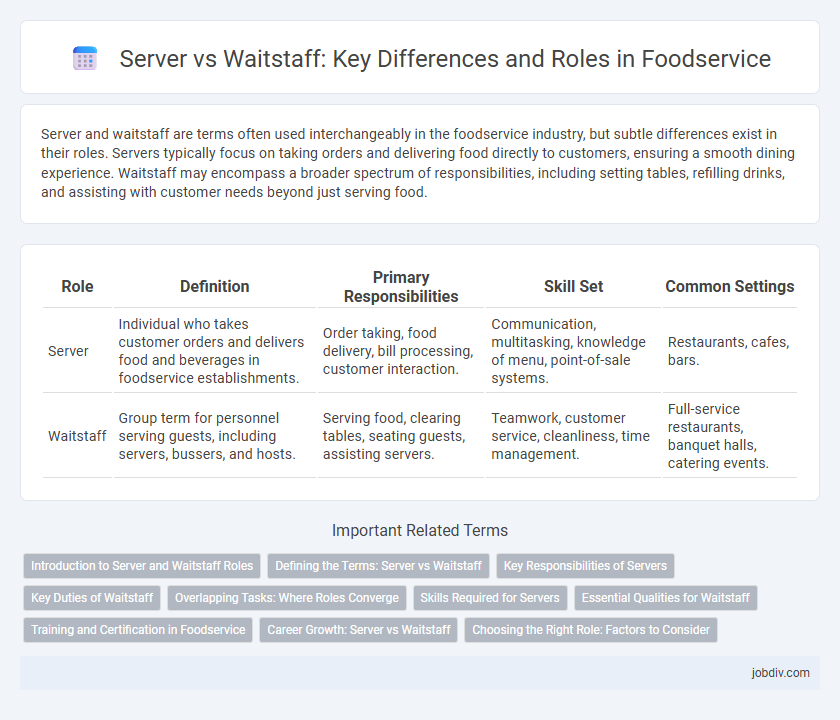Server and waitstaff are terms often used interchangeably in the foodservice industry, but subtle differences exist in their roles. Servers typically focus on taking orders and delivering food directly to customers, ensuring a smooth dining experience. Waitstaff may encompass a broader spectrum of responsibilities, including setting tables, refilling drinks, and assisting with customer needs beyond just serving food.
Table of Comparison
| Role | Definition | Primary Responsibilities | Skill Set | Common Settings |
|---|---|---|---|---|
| Server | Individual who takes customer orders and delivers food and beverages in foodservice establishments. | Order taking, food delivery, bill processing, customer interaction. | Communication, multitasking, knowledge of menu, point-of-sale systems. | Restaurants, cafes, bars. |
| Waitstaff | Group term for personnel serving guests, including servers, bussers, and hosts. | Serving food, clearing tables, seating guests, assisting servers. | Teamwork, customer service, cleanliness, time management. | Full-service restaurants, banquet halls, catering events. |
Introduction to Server and Waitstaff Roles
Server and waitstaff roles in foodservice encompass taking customer orders, delivering food and beverages, and ensuring guest satisfaction throughout the dining experience. Servers actively engage with guests, provide menu recommendations, and handle payments, while waitstaff may include bussers who assist in clearing tables and maintaining cleanliness. Both roles are essential for efficient restaurant operations and enhancing overall customer service quality.
Defining the Terms: Server vs Waitstaff
Server refers specifically to the individual who directly takes orders, serves food and beverages, and attends to customer needs in a foodservice setting. Waitstaff encompasses the broader team of employees responsible for customer service on the dining floor, including servers, bussers, and sometimes hosts. Understanding this distinction helps clarify roles and improve operational efficiency in restaurants and foodservice establishments.
Key Responsibilities of Servers
Servers in foodservice primarily manage customer interactions by taking accurate orders, delivering food and beverages promptly, and addressing special requests or dietary restrictions to ensure guest satisfaction. They maintain clean and organized dining areas, coordinate with kitchen staff to synchronize meal timing, and process payments efficiently. Strong communication skills and attentiveness are essential for servers to enhance the overall dining experience and uphold service standards.
Key Duties of Waitstaff
Waitstaff in foodservice primarily manage order taking, food and beverage delivery, and guest interactions ensuring a smooth dining experience. Their key duties include accurately recording customer orders, coordinating with kitchen staff to ensure timely service, and addressing customer needs or complaints professionally. Effective communication, attention to detail, and maintaining cleanliness and table settings are essential responsibilities distinguishing waitstaff roles.
Overlapping Tasks: Where Roles Converge
Servers and waitstaff share several overlapping tasks in foodservice environments, including taking customer orders, delivering meals, and addressing guest inquiries to ensure a positive dining experience. Both roles require strong communication skills, attention to detail, and the ability to multitask efficiently during peak hours. Collaboration between servers and waitstaff enhances table turnover rates and overall customer satisfaction by streamlining service operations.
Skills Required for Servers
Servers in foodservice must possess strong communication skills to efficiently take orders and address guest needs while maintaining a friendly demeanor. Proficiency in multitasking and time management ensures timely service during busy periods, enhancing overall customer satisfaction. Knowledge of the menu, allergens, and upselling techniques is essential for providing accurate information and maximizing sales.
Essential Qualities for Waitstaff
Essential qualities for waitstaff include strong communication skills, attentiveness, and the ability to multitask efficiently in fast-paced foodservice environments. Waitstaff must display professionalism, patience, and a customer-focused attitude to ensure seamless service and enhance dining experiences. Reliability, teamwork, and knowledge of menu items also contribute significantly to effective waitstaff performance.
Training and Certification in Foodservice
Training and certification for servers and waitstaff in foodservice significantly improve customer service quality and compliance with health regulations. Servers often undergo food safety certification programs such as ServSafe to ensure proper handling and allergen awareness, while waitstaff receive specialized training in customer interaction, menu knowledge, and order accuracy. Investing in ongoing education enhances efficiency, reduces errors, and promotes a safe dining environment.
Career Growth: Server vs Waitstaff
Servers often have more direct interaction with customers, which can enhance communication and sales skills, leading to faster career advancement in hospitality roles like restaurant management or bartending. Waitstaff positions, while similar, may include roles with less customer engagement, potentially limiting immediate opportunities for growth but providing a strong foundation in teamwork and operational efficiency. Both paths offer valuable experience, but servers typically experience more rapid career growth due to increased focus on guest engagement and upselling abilities.
Choosing the Right Role: Factors to Consider
Choosing between a server and waitstaff role depends on factors such as the specific duties involved, work environment, and desired interaction with guests. Servers often focus on taking orders and delivering food and beverages, while waitstaff roles may encompass broader responsibilities including table setup and customer assistance. Assessing your skills in multitasking, communication, and customer service can help determine the best fit within the foodservice industry.
Server vs Waitstaff Infographic

 jobdiv.com
jobdiv.com